Recent Articles
Popular Makes
Body Types
2020 Ford Ranger Road Test and Review
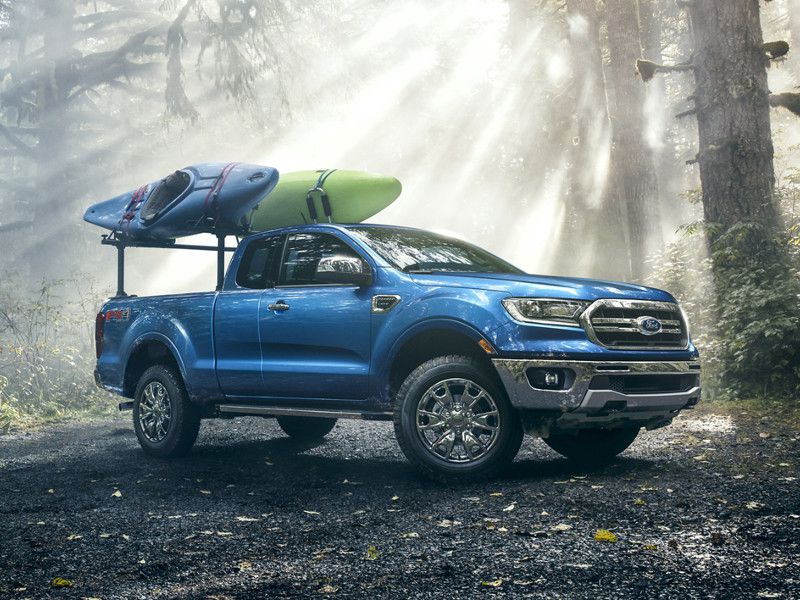
2020 Ford Ranger Lariat FX4 Supercab ・ Photo by Ford
Americans love big pickup trucks. A good full-size pickup combines the heavy-duty utility of a truck with the stretch-out spaciousness and high-end amenities of a large luxury car, along with increasingly impressive gas mileage. Comfortable yet incredibly useful, full-size pickups typically dominate U.S. sales charts.
But not everyone needs or wants a full-size pickup, preferring a less bulky, less expensive model. While the U.S. doesn’t have any truly small pickups, we have a strong class of “mid-size” models that slot below the full-size trucks. They include the 2020 Ford Ranger, which sits below the best-selling F-150 in the brand’s lineup. Measuring nearly 2 feet shorter than the F-150 nose to tail, and costing roughly $10,000 less when comparably equipped, the Ranger also brings a feisty turbocharged engine, best-in-class payload capacity, and a strong suite of advanced safety gear. Let’s go over the details.
Not the Budget Choice
The Ford Ranger spent much of its life as a compact and very affordable pickup. After incentives, you could buy it with crank windows, a small engine, and no backseat for well below $15,000. Today’s Ranger — which appeared as a 2019 model after a seven-year hiatus from the U.S. market — is bigger, more powerful, and better-equipped even in its base form. Naturally, it’s also more expensive, with a starting sticker price of $24,110.
The base 2020 Ranger XL model has workmanlike steel wheels rather than pretty alloys, but otherwise, it’s hardly spartan for a mid-size pickup. A forward-collision warning with automatic emergency braking, built-in Wi-Fi and Bluetooth connectivity, power windows and locks, an automatic transmission, and a 270-horsepower engine all come standard. The XLT brings more safety and infotainment features starting at $28,460, while the top Lariat brings heated, power-adjustable leather seats for $32,500 and up. All trim levels are available with a choice of rear- or four-wheel drive, plus a choice of an extended cab or crew cab body style. Our test vehicle, a 4WD Lariat crew cab, cost about $45,000 with options.
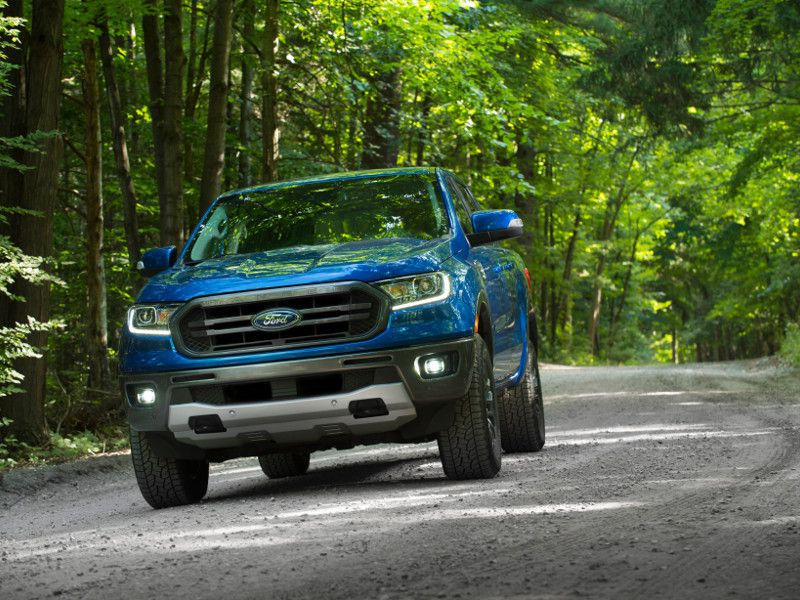
Photo by Ford
Turbo Power
The 2020 Ford Ranger is the only pickup in America that comes only with a four-cylinder engine. But it’s from Ford’s mighty EcoBoost line of turbocharged engines, bringing a hearty 270 horsepower and 310 lb-ft of torque. That’s quite strong for the mid-size pickup class, especially compared to base models of competing vehicles. The engine also has a deep, strong voice for a four-cylinder, and it’s nothing like the rough, agricultural-grade base four-pots on other pickups.
The Ranger’s four-cylinder engine — plus its advanced 10-speed automatic transmission — helps it get impressive gas mileage despite its strong acceleration. The EPA pegs it at 21 mpg in the city, 26 mpg on the highway, and 23 mpg overall with rear-wheel drive and 20 mpg city, 23 mpg highway, and 22 mpg combined with four-wheel-drive. That’s 2 to 3 mpg better than similarly powerful Chevrolet and Toyota mid-size pickups. We averaged about 23 mpg during a weeklong test of a 4WD Ranger.
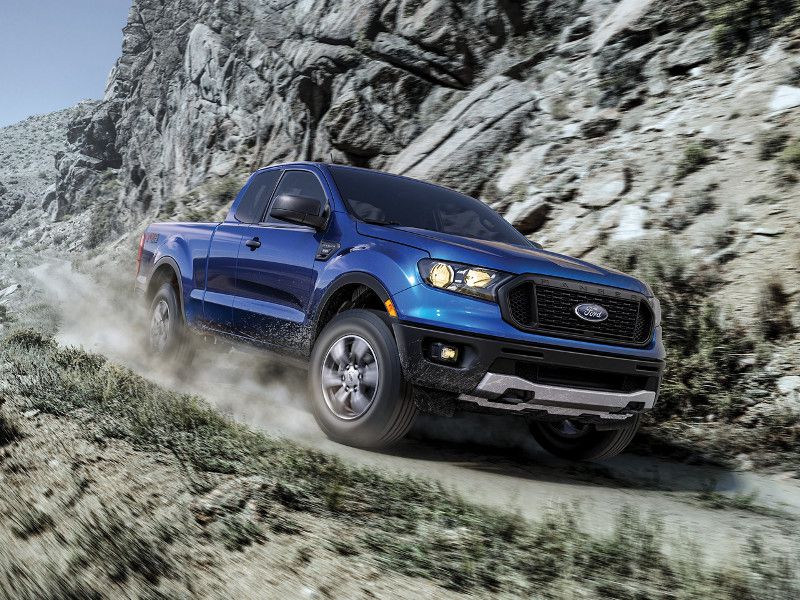
Photo by Ford
Mighty Capability
The Ranger can handle a best-in-class payload of up to 1,860 pounds and tow up to 7,500 pounds when properly equipped. It’s also capable off-road, especially with the tested FX4 package. Available only with four-wheel drive, it brings dedicated driving modes for grass/gravel/snow, mud/ruts, and sand; a “Trail Control” off-road cruise control system; an electronically locking rear differential; an off-road suspension and tires; skid plates; and feedback on the truck’s pitch, roll, and steering angle displayed on an interior screen. For buyers looking for hardy toughness without the extra expense of four-wheel drive, this year brings a new FX2 package for Rangers with two-wheel drive. It shares all FX4 features except the driving modes and Trail Control.
The Ranger’s capability faces a tradeoff in everyday driving, though. While it’s decently quiet, the Ranger has a bouncy on-road ride compared to today’s best mid-size pickups. It also doesn’t handle with great agility or precision, and its 42-foot turning circle is on the wide side. In another negative, every Ranger crew cab has a 5-foot-long bed, without a longer bed option like on some rivals. (The extended cab comes with a 6-foot bed.)
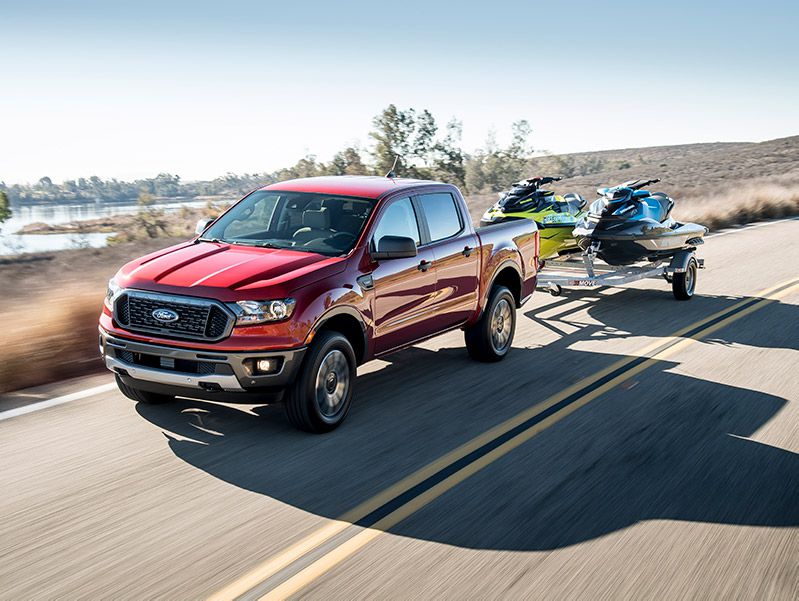
Photo by Ford
Relatively Gentle Style
Many leading mid-size pickup trucks are designed to look butch and tough, for buyers who love the look of a truck as much as its actual utility. While the Ranger is an impressively capable vehicle when it comes to the styling — with the stiff ride to match it — it’s milder-looking than the best-selling Toyota Tacoma or the newly introduced Jeep Gladiator.
That’s because although the Ranger is fairly new to the U.S. market, this Ranger generation has been on sale internationally for nearly a decade. This age, plus the curvier truck styling that’s favored abroad, means the Ranger doesn’t make a bold styling statement. The big rounded taillights give Ranger a dated overall look when seen from behind. Overall, the Ranger's exterior design is closest to the Chevrolet Colorado, another international-market vehicle adapted for U.S. sales. Some buyers will appreciate that the Ranger doesn’t try to visually telegraph its capabilities, but others would appreciate a more extroverted design.
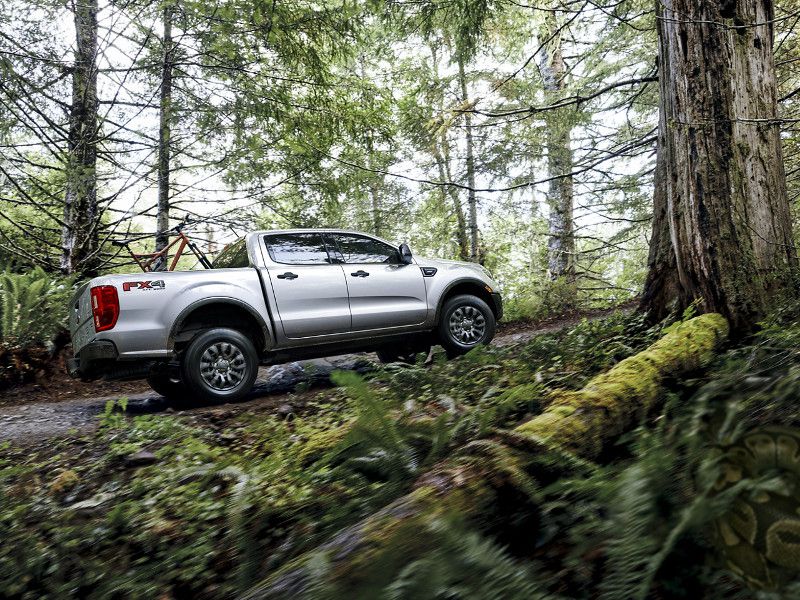
Photo by Ford
Comfortable, Functional Cabin
Like its exterior, the Ranger’s interior doesn’t stand out for style. It’s simple and functional, without the extra-tough vibe of the Tacoma or Gladiator, or the more luxe treatment of the GMC Canyon. The dashboard is a sea of gray with an inoffensive but not overtly truck-like design, with an upright shape but curved details. And the hand-operated parking brake recalls a car more than a truck.
The Ranger’s interior is comfortable, at least, with more space than the Tacoma in both the front and rear seats. Four adults can fit without much squeezing in the tested crew cab model, which features four full-size doors. We appreciated the way Ford carefully shaped the front seatbacks to maximize rear knee space. As with the competition, the extended cab’s rear seat area is designed only for emergency seating or a bit of cargo.
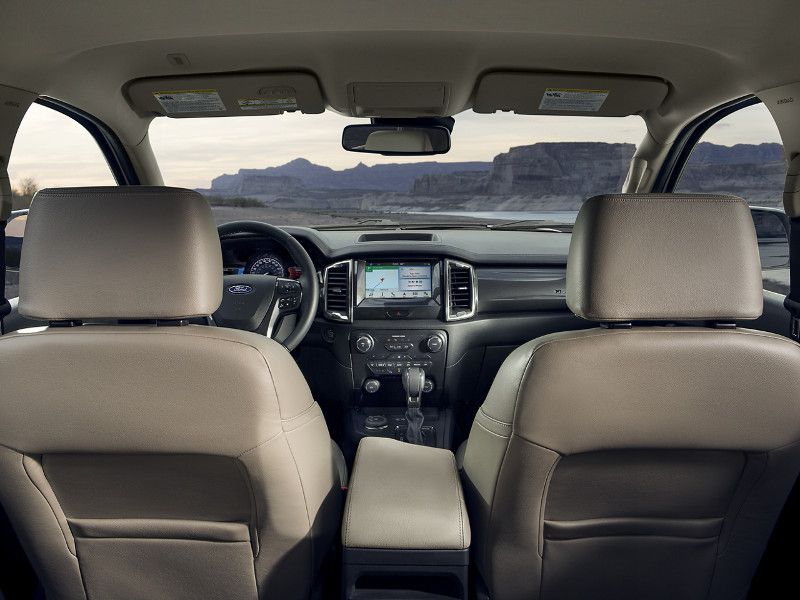
Photo by Ford
Up-to-Date Infotainment
One area where the Ford is purely modern is its Sync 3 infotainment system, which is standard on the XLT and Lariat trim levels. It features a generously sized 8-inch touchscreen with Android Auto and Apple CarPlay smartphone integration, pinch-to-zoom capabilities, clear displays, and quick responses. Ford also lets you use physical buttons and knobs for everyday functions, which we appreciate; some cars bury certain functions in the touchscreen’s submenus.
Two competitors just caught up with the Ranger’s infotainment, though; this year, Toyota added a similarly large screen, Android Auto, and Apple CarPlay to the Tacoma, and the Honda Ridgeline made these features more widely available instead of limiting them to high-end trim levels. But the Nissan Frontier still has a smaller screen without advanced smartphone integration.
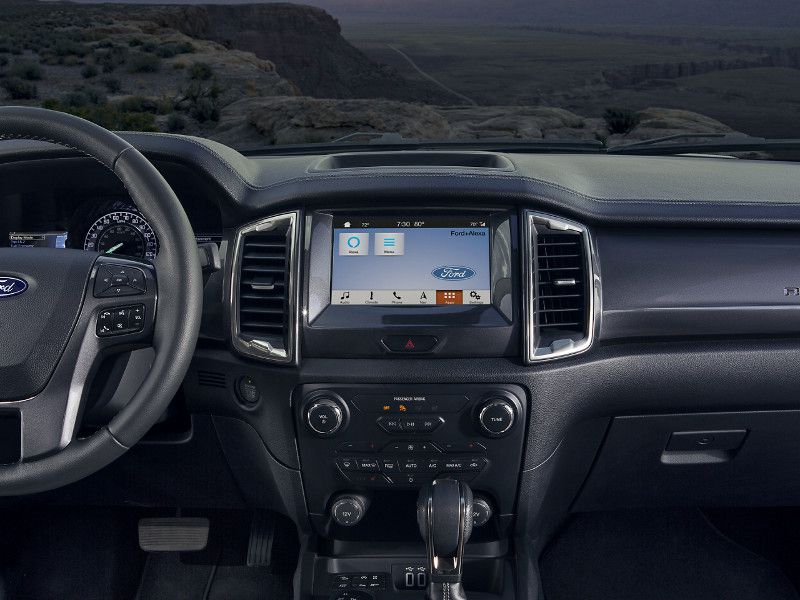
Photo by Ford
Standout Safety
The Ranger is one of the leading mid-size pickups for safety, thanks to its advanced technology and strong crash performance. It earned top ratings in nearly all Insurance Institute for Highway Safety and National Highway Traffic Safety Administrations crash tests, in line with the Toyota Tacoma and Honda Ridgeline at the top of the class.
The Toyota and Honda are also Ford’s top rivals for safety technology. A forward collision warning with automatic emergency braking is standard equipment on every 2020 Ranger, while a more complete suite that adds blind-spot monitoring, a rear cross-traffic alert, a lane-departure warning, and lane-keeping steering corrections is optional on the base XL and standard on other trim levels. Adaptive cruise control is optional on the Ranger but standard on the Ridgeline and Tacoma. Most advanced driver-assistance systems remain optional on the Jeep Gladiator and unavailable on the Nissan Frontier, Chevrolet Colorado, and GMC Canyon.
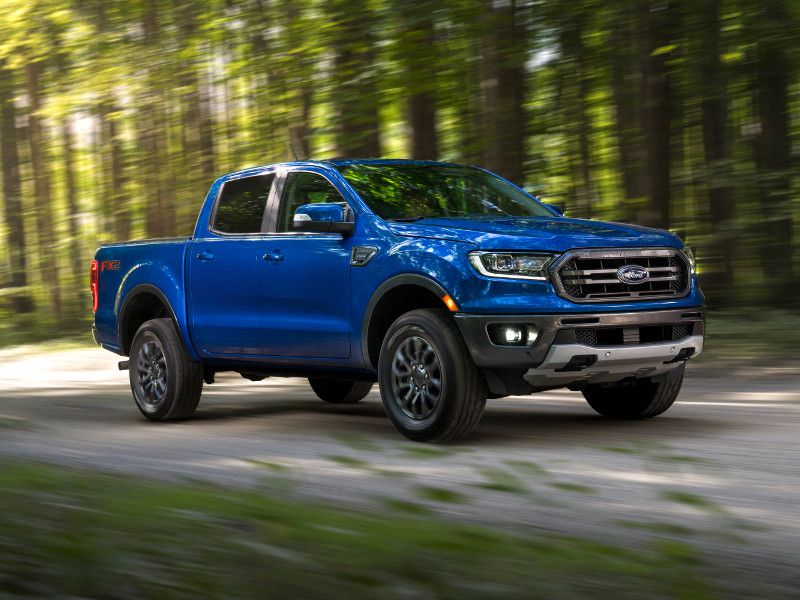
Photo by Ford
Competitors to Consider
The Ranger’s closest competitors are the Chevrolet Colorado and the Toyota Tacoma, but it isn’t quite like either of them. It takes a similar stylistic vibe to the Colorado, and like the Chevy, it’s roomier than the Toyota. But the Ranger has a lot more safety technology and better crash-test scores, while the Colorado rides more smoothly and tends to cost less. Against the Tacoma, the Ranger has a similarly bouncy ride and similar safety, but the Tacoma looks more like a tough truck inside and out. The Ranger’s EcoBoost four-cylinder engine delivers superior fuel economy to both, along with speedier acceleration than the Toyota.
Elsewhere in the mid-size pickup field, the GMC Canyon is a Chevy Colorado with boxier styling and some extra optional equipment. The Honda Ridgeline offers an extra-smooth ride and extra-spacious interior, though its lighter-duty unibody structure isn’t designed to take as much of a beating as body-on-frame pickups. The Jeep Gladiator has uniquely retro styling and lets you take off the roof and doors, but it’s expensive. And the Nissan Frontier offers solid utility at budget prices but feels more basic than its fresher competitors.
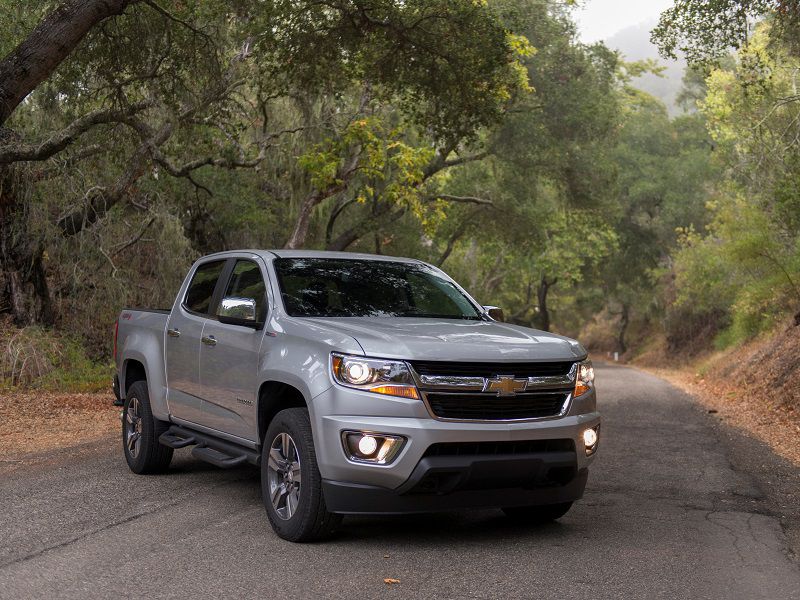
Photo by Chevrolet
A Worthy Contender
The 2020 Ford Ranger is a worthy entrant into the mid-size pickup segment. In particular, its outstanding powertrain — which brings smooth, lively power along with impressive gas mileage — gives it a leg up over the competition. Its usefully spacious interior and top-tier hauling and off-road capabilities keep it useful, and its high-end safety features and strong crash-test scores round out a compelling overall package.
The Ranger’s bouncy ride will limit its appeal among buyers just seeking a useful everyday pickup, while those seeking a rough-and-tumble lifestyle vehicle might wish for more interesting styling. But given that no competitor is perfect either, the Ranger’s strengths will outweigh its downsides for the right buyer. We’ll just emphasize again that today’s Ranger is an advanced, spacious, and highly capable mid-size pickup — not the small, basic, bargain-priced truck it was a decade ago.
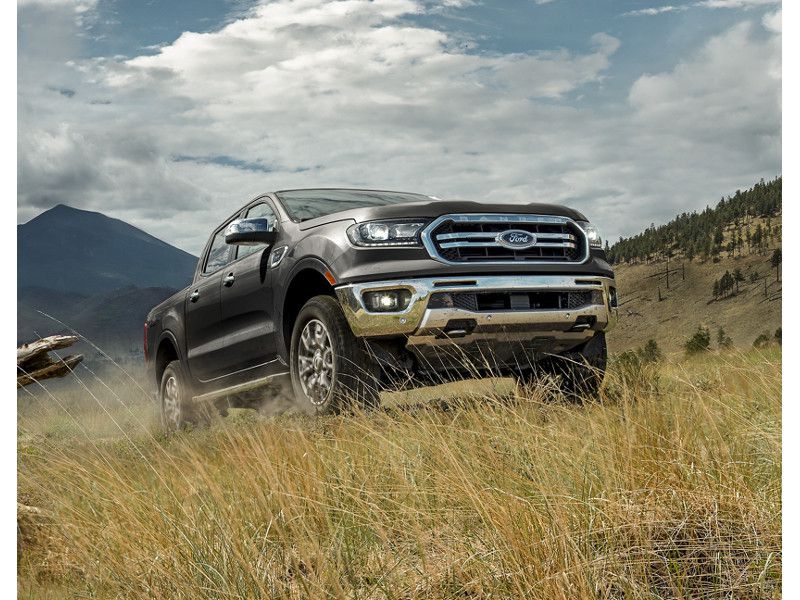
Photo by Ford